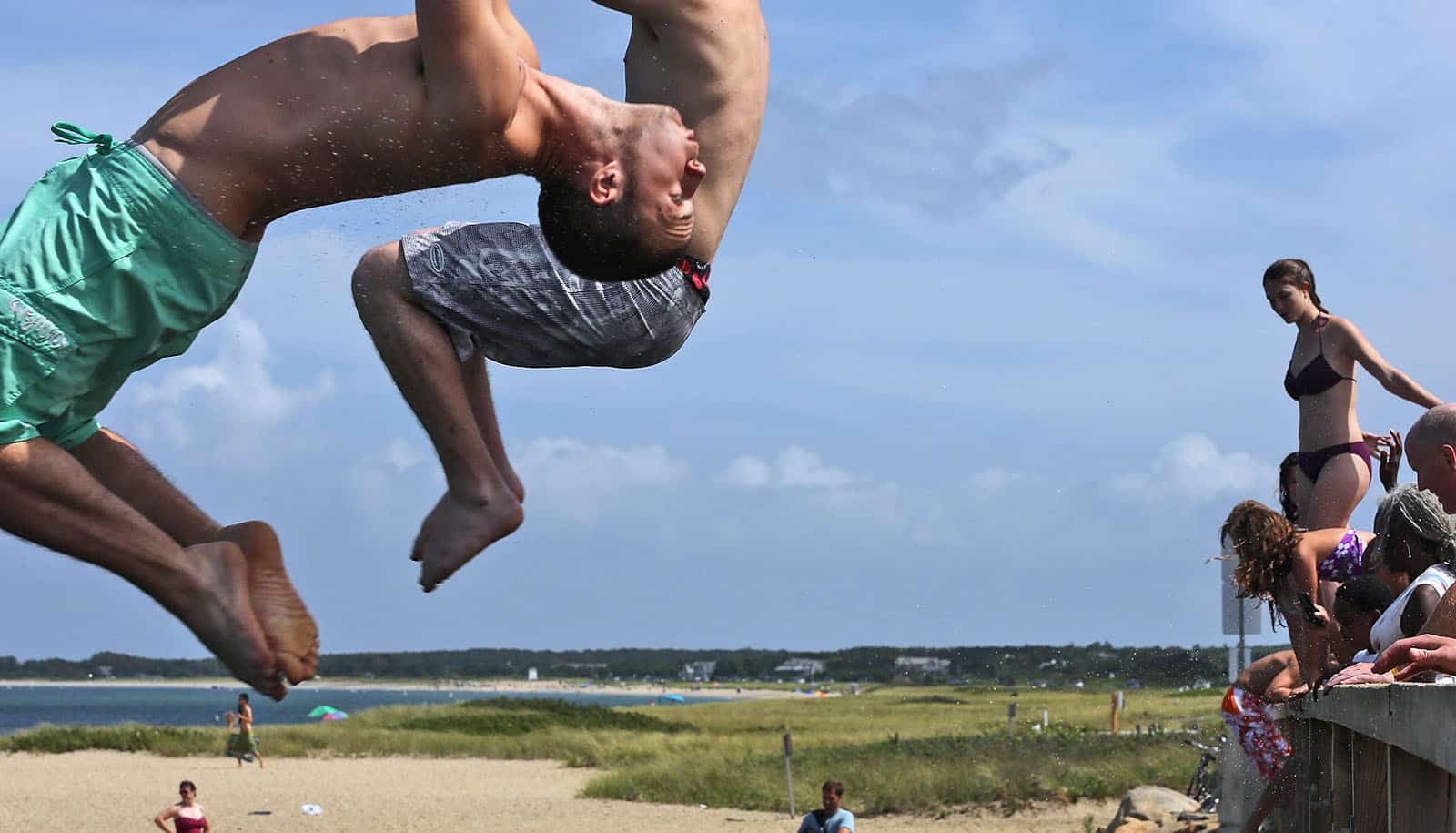The ability of people in New England to safely go swimming is under threat even as climate change makes beating the heat even more important for public health.
With dozens of local beaches and lakes closed due to harmful bacteria, great white shark sightings at many open ones, and public pools off limits amid a long-term lifeguard shortage, residents have had to rethink one of the region’s most reliable heat-mitigation strategies.
“Heat is considered the number one health threat from weather extremes,” says Gregory Wellenius, a professor of environmental health at Boston University School of Public Health and director of its Center for Climate and Health. “More people die of heat-related illness, and extreme heat, than from any other meteorological hazards.”
What will become of New England ocean and lake swimming? How will we cool off without public pools? Here, experts discuss sharks, bacteria, and public health:
Are sharks a risk to New England swimmers?
While great white shark sightings off Cape Cod were considered relatively rare for decades, great whites—the largest member of the mackerel shark family, and the species with the most recorded fatal attacks on humans—are, in fact, native to North Atlantic waters. Their populations off the New England coast ebbed for centuries as a result of overfishing and the culling of one of their main food sources, the gray seal. The Marine Mammal Protection Act of 1972 helped restore both populations—sharks and seals—to their former vigor. Cape Cod is now home to one of the largest great white concentrations on Earth.
“It really becomes an issue of selfishness. Do you want to get in the water, or do you want to have wildlife?”
“When we protect species, it’s usually when they’re declared on the verge of extinction, or highly threatened,” says biology professor Phillip S. Lobel. “The fact that the shark populations have come back means we were successful as ecologists and conservationists.”
The success of the conservation program was cause for celebration among ecologists like Lobel; for the beach-going public, it was cause for alarm. Beach closures due to shark sightings now happen yearly up and down the Northeast coast. But does a sighting always indicate a clear and present danger? It’s hard to say.
“Predators want easy prey, and they’re not looking to put up a fight,” says Lobel, who adds that humans are far from a great white shark’s snack of choice. While studies have shown that sharks will mostly move around or ignore people, attacks do happen on rare occasions. According to a New York Times story, five attacks—including one fatal—were recorded on Cape Cod between 2012 and 2021. Still, given the hundreds of sharks counted off Cape Cod in recent years, five attacks in just under a decade represents a low likelihood of danger.
“Every animal attacks when it’s motivated,” says Lobel, “but not every animal is motivated to attack all the time.”
Erring on the side of caution, the National Park Service has equipped some beaches with emergency call boxes and “Stop the Bleed” kits; meanwhile, an emerging group of shark tourists has embraced the new normal, and a number of Cape Cod towns have been eager to capitalize on them.
“If you now have sharks and seals everywhere from Nova Scotia down through the Gulf of Maine, could you wipe them off of a Chatham beach, so that tourists are protected?” Lobel asks. “I don’t think you can really do that kind of large-scale management.”
If you’re at the beach and you see a shark, it might be time to consider that you are the one who’s in a place you shouldn’t be.
“It really becomes an issue of selfishness,” Lobel says. “Do you want to get in the water, or do you want to have wildlife?”
Bacteria foul swimming spots
A rainy summer has its pros and cons: in the pro column, homeowners and municipal leaders don’t have to worry about droughts and water bans. However, on the downside, the heavy regional rainfall seen this summer can also give rise to abundant bacterial growth in previously safe swimming areas—which poses serious swimming risks on hot, dry days.
In July, the Boston Globe reported that more than 70 Massachusetts beaches had been closed due to bacterial contamination, as heavy rain in the area had caused wastewater and stormwater systems to flood and “discharge… into nearby waterways.”
In saltwater environments, the Massachusetts Department of Public Health tests for Enterococci, a lactic acid bacteria; in freshwater, E. coli and Enterococci levels are tested. If samples exceed advised limits for more than two days, the area is closed for public use.
Freshwater tests also look for cyanobacteria, a cluster of photosynthetic microbes that bloom yearly in freshwater. This summer, cyanobacteria have proliferated in New England, particularly in New Hampshire lakes and ponds, where a record-breaking 34 alerts were issued in June and July.
“Blooms are mostly caused by two specific things: nutrients and high temperature,” says Jeffrey Marlow, an assistant professor of biology. “A lot more nutrients are now becoming available for cyanobacteria because of big storms, and high temperatures make everything grow faster.”
Microbes like cyanobacteria already exist at manageable levels in most freshwater environments, Marlow says. When rainwater drives phosphorus- and nitrogen-rich fertilizer to run off into the waterway, the effect is similar to that of a shark population feasting on an unlimited supply of seals: unencumbered growth.
“Nitrogen, phosphorus, and iron are probably the three things that are hardest to come by in the marine environment for these cyanobacteria,” says Marlow. “The runoff associated with these rainstorms is giving them all the nitrogen and phosphorus they need, but they still need iron, so they make microcystins [in order to better absorb it from their environment].”
Microcystins are one of the species of toxins found in cyanobacteria that are harmful to humans and animals; like E. Coli and Enterococci, they can cause a range of symptoms, including skin and eye irritation, abdominal pain, gastrointestinal distress, and flu-like symptoms.
Given that heavy rains and hot weather are both associated with climate change, Marlow says it’s reasonable to expect bacterial blooms to become more prevalent in the future. However, he says, the issue may be mitigated by minimizing fertilizer use or perhaps even by introducing sugar to freshwater environments, which, lab studies have indicated, “allows other microbes to outcompete the cyanobacteria so you don’t just have a [cyanobacteria] monoculture.”
In the meantime, you should probably keep checking your local water-quality report.
Sorry, pool’s closed
As if sharks and bacteria weren’t enough, there’s also trouble brewing at public pools due to a years-long national lifeguard shortage.
“This is a widespread problem,” says Wellenius, “but it becomes especially important when we suggest to people that they make sure to stay cool, that they go to swimming pools and the beach.”
The closure of a local municipal pool means that a valuable cooling resource has just been taken away.
In many municipalities, pools are required by local boards of health to close if there is no lifeguard on duty. This summer, Massachusetts took mitigating steps by offering incentives—such as increased pay, sign-on bonuses, and free certification training—but not all pool closures have the lifeguard shortage to blame: the Boston Globe reported that, amid one recent heatwave, more than half of Boston’s municipal pools were closed due to “various work and projects going on at the locations that host the pools.”
For those who don’t have home air-conditioning, reliable transportation, or the money for a daily swim pass, the closure of a local municipal pool means that a valuable cooling resource has just been taken away.
“I think we need to do a better job of identifying who are the most vulnerable individuals and communities so that we can direct more resources there,” Wellenius says, “but when we think of who’s at risk of the health impacts of heat, we should understand that everybody’s at risk.”
Some of these resources, he notes, might not include swimming areas. As it becomes harder and harder for the general public to have access to a safe, clean swim, it might be time to get more creative about how we keep cool.
“I love what I’m seeing [in Boston],” Wellenius says. “They have a concrete heat resilience plan and they’re taking it very seriously.”
The city of Boston’s heat resilience plan includes initiatives such as city-run cooling centers, new guidelines for outdoor worker safety, increased shade areas on municipal grounds, and an expanded network of public drinking fountains.
Still, Wellenius cautions, there’s no one-size-fits-all solution when it comes to heat mitigation across populations—just as there’s no one way to keep recreational waters safe and accessible for all.
“Different strategies might be needed in different communities,” he says. “The data shows that there’s still much more to do, there’s still more room for improvement—so we have to keep at it.”
Source: Sophie Yarin for Boston University



